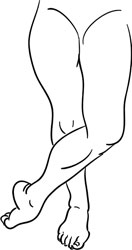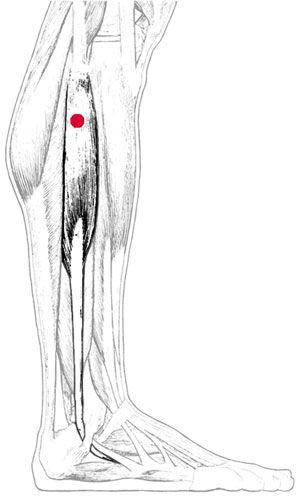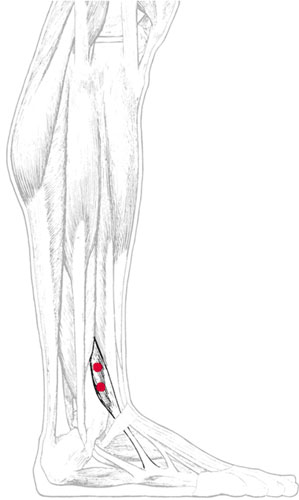Trigger Point Therapy for Myofascial Pain (35 page)
Read Trigger Point Therapy for Myofascial Pain Online
Authors: L.M.T. L.Ac. Donna Finando

Pain pattern:
Pain at the anteromedial ankle and the great toe. Some pain may be experienced along the course of the shin to the ankle. Symptoms associated with trigger points may include ankle weakness, tripping or falling when walking because of weak dorsiflexion, and foot drop.
Causative or perpetuating factors:
Muscle overload that may occur secondary to ankle sprain or fracture; walking on rough ground or slanted surfaces; excessive tightness in the triceps surae.

Tibialis anterior pain pattern
Satellite trigger points:
Peroneus longus, extensor hallucis longus, possibly extensor digitorum longus.
Affected organ systems:
Digestive system.
Associated zones, meridians, and points:
Lateral zone; Foot Yang Ming Stomach meridian; ST 36â40; LIV 4.
Stretch exercise:
Stretch the tibialis anterior by crossing a strongly pointed foot over the ankle of the standing leg. Bend the knee of the standing leg into the back of the knee of the bent leg. Care should be taken to ensure that the heel is raised and that the ankle is neither supinated nor pronated.
Strengthening exercise:
Stretch a dynaband or other elastic exercise band between the legs of a chair or table 3 to 4 inches from the floor. Sit on the floor with the legs extended and position the foot so the band lies across the dorsum of the foot (not across the toes). Flex and supinate (invert) the foot against the resistance provided by the band. Hold for a count of three to five. Repeat five to ten times.

Stretch exercise:Tibialis anterior

Peroneus longus

Peroneus brevis

Peroneus tertius
Peroneals and trigger points
P
ERONEAL
M
USCLES
P
ERONEUS
L
ONGUS
P
ERONEUS
B
REVIS,
PERONEUS TERTIUS
Proximal attachment:
Peroneus longus:
head of the fibula and upper two-thirds of the lateral surface of the fibula and the adjacent intermuscular septa.
Peroneus brevis:
lying deep to longus, distal two-thirds of the lateral surface of the fibula and the adjacent intermuscular septa.
Peroneus tertius:
distal one-half of the anterior margin of the fibula and the adjacent intermuscular septum, in common with the lower fibers of extensor digitorum longus.
Distal attachment:
Peroneus longus:
passing behind the lateral malleolus, running obliquely across the sole of the foot from lateral to medial, and ending on the base of the first metatarsal and the medial cuneiform bones.
Peroneus brevis:
passing behind the lateral malleolus, ending at the dorsal surface of the base of the fifth metatarsal.
Peroneus tertius:
passing in front of the lateral malleolus, ending on the dorsal surface of the base of the fifth metatarsal.
Action:
Peroneus longus and peroneus brevis:
eversion and weak plantar flexion of the foot; controls excessive inversion and mediolateral balance in walking.
Peroneus tertius:
dorsiflexion and eversion of the foot. As a group the peroneals are prime movers in the eversion of the free foot, working with extensor digitorum longus.
Palpation:
Peroneus longus and peroneus brevis comprise the lateral compartment of the leg. Peroneus tertius, along with tibialis anterior, extensor digitorum longus, and extensor hallucis longus, comprise the anterior compartment of the leg. To palpate the peroneals, first identify the head and shaft of the fibula and the extensor digitorum longus, which lies just anterior to peroneus longus. Peroneus longus taut bands can be easily identified against the shaft of the fibula. Trigger points in peroneus longus are most commonly found approximately 1 inch distal to the head of the fibula.
For peroneus brevis, palpate along the shaft of the fibula on either side of longus, near the junction of the middle and lower thirds of the leg. Unlike longus and brevis, peroneus tertius lies proximal and anterior to the lateral malleolus. Palpate fibers of peroneus tertius distal and anterior to brevis. The tendon of peroneus tertius is readily palpable and observable in the anterolateral aspect of the foot, lateral to the extensor digitorum longus tendon, when the patient everts the foot.
Pain pattern:
For peroneus longus and brevis, the pain pattern is over the lateral malleolus: above, behind, and below it and possibly along the lateral aspect of the foot. For peroneus tertius, the pain pattern is over the anterolateral aspect of the ankle, anterior to the lateral malleolus, with some pain on the outer side of the heel. Symptoms include weak or unstable ankles; there are complaints of pain and tenderness in the ankle over the lateral malleolus, particularly after an inversion sprain. Tenderness due to trigger points can be differentiated from a lateral ligament injury by the absence of swelling in the immediate area and the presence of pain in a larger, more diffuse area.

Peroneus longus and Peroneus brevis

Peroneus tertius
Peroneals pain pattern
Causative or perpetuating factors:
Ankle inversion or twisting; prolonged immobilization of the leg and foot by a cast; chronic tightness of the tibialis anterior or tibialis posterior; crossing legs when seated, wearing high heels; tight elastic around the leg; flat feet; sleeping with the feet strongly plantar flexed; as satellite trigger points from trigger points existing in anterior fibers of gluteus minimus.
Satellite trigger points:
Peroneus longus, peroneus brevis, peroneus tertius, extensor digitorum longus, tibialis anterior, tibialis posterior, extensor hallucis longus, flexor hallucis longus.
Affected organ systems:
Gastrointestinal system.
Associated zones, meridians, and points:
Lateral zone; Foot Shao Yang Gall Bladder meridian; GB 37â40.
Stretch exercise:
Sit with the leg to be stretched extended in front of you. Place a strap or towel around the foot. Holding the towel, pull the foot gently, allowing it to move into dorsiflexion, inversion, and adduction. Hold the position for a count of fifteen to twenty. Repeat three to five times.
Strengthening exercise:
Due to the nature of this muscle, strengthening exercises are generally not necessary.
